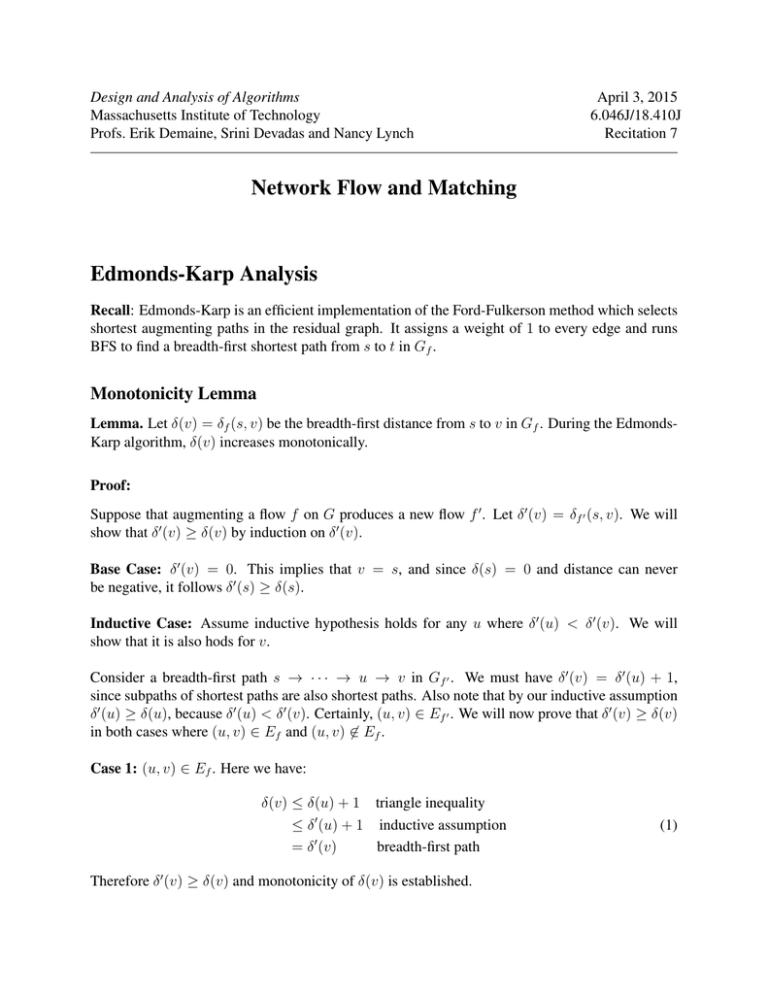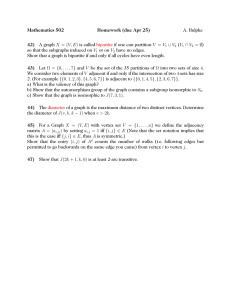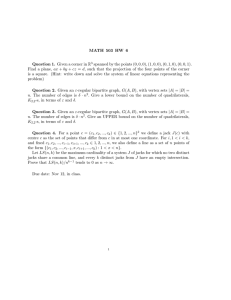Design and Analysis of Algorithms April 3, 2015 Massachusetts Institute of Technology 6.046J/18.410J
advertisement

Design and Analysis of Algorithms
Massachusetts Institute of Technology
Profs. Erik Demaine, Srini Devadas and Nancy Lynch
April 3, 2015
6.046J/18.410J
Recitation 7
Network Flow and Matching
Edmonds-Karp Analysis
Recall: Edmonds-Karp is an efficient implementation of the Ford-Fulkerson method which selects
shortest augmenting paths in the residual graph. It assigns a weight of 1 to every edge and runs
BFS to find a breadth-first shortest path from s to t in Gf .
Monotonicity Lemma
Lemma. Let δ(v) = δf (s, v) be the breadth-first distance from s to v in Gf . During the EdmondsKarp algorithm, δ(v) increases monotonically.
Proof:
Suppose that augmenting a flow f on G produces a new flow f / . Let δ / (v) = δf ' (s, v). We will
show that δ / (v) ≥ δ(v) by induction on δ / (v).
Base Case: δ / (v) = 0. This implies that v = s, and since δ(s) = 0 and distance can never
be negative, it follows δ / (s) ≥ δ(s).
Inductive Case: Assume inductive hypothesis holds for any u where δ / (u) < δ / (v). We will
show that it is also hods for v.
Consider a breadth-first path s → · · · → u → v in Gf ' . We must have δ / (v) = δ / (u) + 1,
since subpaths of shortest paths are also shortest paths. Also note that by our inductive assumption
δ / (u) ≥ δ(u), because δ / (u) < δ / (v). Certainly, (u, v) ∈ Ef ' . We will now prove that δ / (v) ≥ δ(v)
in both cases where (u, v) ∈ Ef and (u, v) ∈ Ef .
Case 1: (u, v) ∈ Ef . Here we have:
δ(v) ≤ δ(u) + 1 triangle inequality
≤ δ / (u) + 1 inductive assumption
= δ / (v)
breadth-first path
Therefore δ / (v) ≥ δ(v) and monotonicity of δ(v) is established.
(1)
2
Recitation 7: Network Flow and Matching
Case 2: (u, v) ∈ Ef . Here, the only way (u, v) ∈ Ef ' is if the augmenting path p that produced f /
from f must have included (v, u). Moreover, p is a breadth first path in Gf :
p = s → ··· → v → u
Thus, we have:
δ(v) = δ(u) − 1 breadth-first path
≤ δ / (u) − 1 inductive assumption
= δ / (v) − 2 breadth-first path
< δ / (v)
(2)
thereby establishing monotonicity for this case, too. D
Counting Flow Augmentations
Theorem. The number of flow augmentations in the Edmonds-Karp algorithm is O(V E).
Proof:
For an augmenting path p, define cf (p) = min{cf (u, v) ∈ p}.
Let p be an augmenting path, and suppose that we have cf (p) = cf (u, v) for edge (u, v) ∈ p. Then,
we say that (u, v) is critical, and it disappears from the residual graph after flow augmentation.
This is because during augmentation, the residual capacity of every edge in p decreases by cf (p)
as that much new flow is pushed through the augmenting path. And since cf (u, v) − cf (p) = 0,
the edge disappears after augmentation.
The first time an edge (u, v) is critical, we have δ(v) = δ(u)+1 since p is a breadth-first path. After
the augmentation, we must wait until (v, u) is on an augmenting path before (u, v) can be critical
again. Let δ / be the distance function in the residual network when (v, u) is on an augmenting path.
Then, we have:
δ / (u) = δ / (v) + 1 breadth-first path
≥ δ(v) + 1 monotonicity
= δ(u) + 2 breadth-first path
(3)
Hence between each occurrence of an edge (u, v) as critical, δ(u) increases by at least 2. And since
δ(u) starts out non-negative and can be at most |V | − 1 until the vertex is unreachable, each edge
can be critical O(V ) times. And since the residual graph contains O(E) edges, the total number of
flow augmentations is O(V E). D
Corollary. The Edmonds-Karp maximum-flow algorithm runs in O(V E 2 ) time.
Proof: Breadth-First Search runs in O(E) time, and there are O(V E) augmentations. All other
bookkeeping is O(V ) per augmentation.
Recitation 7: Network Flow and Matching
3
Applications of Network Flow
Vertex Cover
Given an undirected graph G = (V, E), we say that a set S ⊆ V of vertices covers G, if for every
edge (u, v) ∈ E, S contains either u or v. The Vertex Cover problem is now to find S such that S
covers G and |S| is minimal.
Vertex Cover is NP-Hard in general graphs but polynomial time solvable in bipartite graphs.
Bipartite Vertex Cover
Given a bipartite graph G = (L U R, E ⊆ L × R), find the set S such that S covers G and |S| is
minimal.
Solution: Given G, define the following Flow Network H:
• Create a new source vertex s and add edges of capacity 1 from s to every vertex in L
• Create a new sink vertex t and add edges of capacity 1 from every vertex in R to t
• Direct all edges in E from L to R and assign each edge ∞ capacity
Run Maximum Flow in H and return the value.
For example, consider the following graph H constructed from G = ({L1 , L2 , L3 }U{R1 , R2 , R3 }, E)
where E consists of the shown edges:
∞
L1
R1
1
∞
1
1
s
1
∞
L2
R2
∞
1
t
1
L3
R3
∞
In this example, the Maximum Flow is 2, and the minimal vertex cover is Q = {L1 , R3 } and
|Q| = 2.
4
Recitation 7: Network Flow and Matching
Correctness of Bipartite Vertex Cover as Maximum Flow
Claim 1: Every Vertex Cover Q of H defines an (S, T ) cut of a finite value c(S, T ).
Proof: Let Q = QL U QR where QL = Q ∩ L and QR = Q ∩ R. Then define the cut (S, T )
as follows:
S = {s} ∪ QR ∪ (L\QL )
T = {t} ∪ QL ∪ (R\QR )
Proof by picture:
QL
R\QR
t
s
L\QL
QR
Note that there cannot be any edges going from L\QL to R\QR because if there were such an edge,
both endpoint vertices would not be covered and would contradict that Q was a valid vertex cover.
From the picture it is clear that (S, T ) is indeed a cut in H. It is also clear that c(S, T ) = QL + QR
because the only edges that cross the cut (S, T ) are all the edges from s to QL and from QR to t,
and each of them have capacity 1. D
Claim 1 implies that c(S ∗ , T ∗ ) ≤ |Q∗ | where Q∗ is the minimum Vertex Cover of G and (S ∗ , T ∗ )
is the minimum cut in H.
Claim 2: For any finite cut (S, T ) in H, the set Q = (S ∩ R) ∪ (T ∩ L) is a Vertex Cover of
G.
Proof: Observe the following picture:
Recitation 7: Network Flow and Matching
T ∩L
5
T ∩R
t
s
S∩L
S∩R
Note that there cannot be any edges going from S ∩ L to T ∩ R because that would make c(S, T )
infinite and contradict the assumption that the cut must be of finite capacity. From this picture,
it is clear that every edge in G has at least one end point in either T ∩ L or S ∩ R and indeed
Q = (S ∩ R) ∪ (T ∩ L) covers G. It is also clear that |Q| = |S ∩ R| + |T ∩ L| = c(S, T ). D
Claim 2 implies that |Q∗ | ≤ c(S ∗ , T ∗ ) where (S ∗ , T ∗ ) is the minimum cut in H and Q∗ is the
minimum Vertex Cover of G.
Punchline:
By claims 1 and 2, the size of the minimum Vertex Cover of G, |Q∗ | is equal to the size of minimum
cut (S ∗ , T ∗ ). And since the Maximum Flow is equal to the Minimum Cut, we can use Maximum
Flow to solve Bipartite Vertex Cover in the way described above.
MIT OpenCourseWare
http://ocw.mit.edu
6.046J / 18.410J Design and Analysis of Algorithms
Spring 2015
For information about citing these materials or our Terms of Use, visit: http://ocw.mit.edu/terms.




